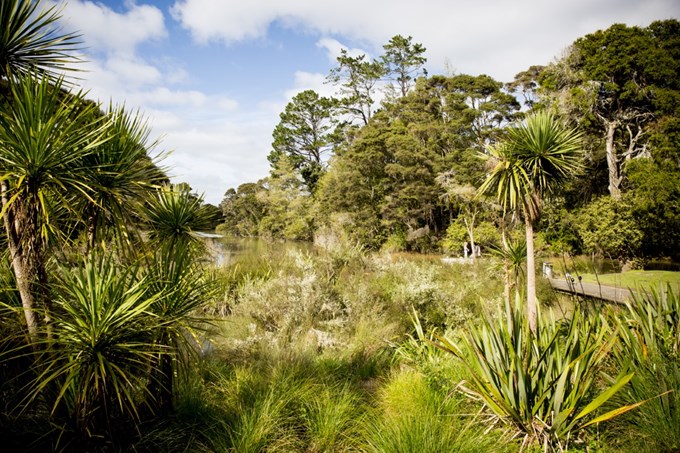When Auckland Council and the community work together on improving our environment, you can see the results.
“Aucklanders overwhelmingly supported the natural environment targeted rate because they want to leave a green, healthy, beautiful region for their kids and grandchildren,” says Mayor Phil Goff.
“In just six months, we’ve seen how council initiatives and community participation can protect and enhance our environment.
"It shows we’re on the right track with our 10-year environmental programme, made possible by Aucklanders through the $311 million natural environment targeted rate."
“This new rate is a significant step change in previous investment to protect our green spaces, and we’re getting on a doing the work to make a real difference. We’re not shying away from the tough problems that we currently face including increased pest control and kauri dieback, says Penny Hulse, Chair of the Environment and Community Committee.
“While some projects will take several years to show gains, we’re already seeing the benefit of our new commitment to the environment,” says Auckland Council Biodiversity Manager Jonathan Boow.
The big projects
We’ve made significant progress on some major projects in the last six months.
- Four tracks around the Kitekite Falls in the Waitākere Ranges have re-opened now we’ve brought them up to “kauri-safe” standards.
- More than 30 kauri dieback ambassadors stationed around Auckland over the summer helped prevent the spread of the disease. A kauri dieback cleaning station was added to Pier 2 so those heading to gulf islands could clean their gear.
- We’re increasing council-community collaboration, capacity and on-the-ground delivery with a community co-ordination and facilitation grant. Grants of $740,000 have been allocated to 34 successful applicants. Of this, over $100,000 was contributed from the Water Quality Targeted Rate in a great collaborative effort towards environmental outcomes
- We’re delivering more support for community conservation with an extra $200,000 allocated to 29 projects in December 2018 through the Regional Environment and Natural Heritage Grant
- Enviroschools is expanding across Auckland to support increased education for sustainability outcomes with rangatahi.
- Since July 2018 we have directly supported an additional 45 community groups, including iwi, and projects with $407,000 of tools and resources including pest animal and weed control hardware, nursery supplies and monitoring equipment to support regionally significant conservation projects.
- Successful rat and possum control through the 1080 programme in Hunua Regional Park and privately-owned land adjoining the park to reduce reinvasion pressure. There are now 106 breeding pairs of kōkako in the forest, nearly double those counted in 2014.
- Our pest detection dog squad has two new inspectors and dogs. We now have 12 dogs that specialise in rodents, plague skinks, stoats and ferrets. They’ve been patrolling ferries and vehicles heading to gulf islands as well as responding to incursions.
- Nine ambassadors were stationed at ferry terminals over the summer to engage Aucklanders in the fight against spreading pests and pathogens to our Hauraki Gulf islands.
- We’re sharing data with other organisations including Waikato Regional Council, Land Information New Zealand and NIWA with a focus on our gulf waters.
- We’re partnering with the Department of Conservation on a better volunteer management system so that Aucklanders can participate more easily in community conservation activities.
The birds are returning
“We’re seeing some real gains thanks to the power of the collective effort that is needed to restore the region's biodiversity because the scale of the challenge is too great for any one agency or person to achieve on their own,” says Brett Butland, Pest Free Auckland Director.
- Kakariki have returned to Le Roys Bush in Birkenhead.
- There are bellbirds along Whangaparaoa Peninsula.
- There has been a reliable sighting of bellbirds in Ōrākei.
- There are kaka in Northcote and in the eastern city suburbs including Kohimarama, Mission Bay and Glen Innes.
We’re also seeing other species thriving. A long-tailed bat has taken up residence in a domestic settling in Patumahoe. Weta are establishing at various sites through the Manukau lowlands, with the community setting up weta motels. More kereru are being seen in the Portland Road area of Remuera.
Trapping is a key part of pest-removal
“Auckland Council promotes and uses humane methods and we want landowners to use the right trap the right way. We can help with advice, there’s the Predator Free NZ website, workshops through the Department of Conservation and support from local community conservation groups,” says Brett.
Brett Butland sums up the past six months well. He says getting support and participation from the whole community is critical for success, and these examples show just how quickly we can remove pests and create havens when the council and Aucklanders work together.


